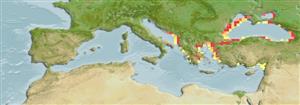分类 / Names
俗名 | 同种异名 | Catalog of Fishes(属, 种) | ITIS | CoL | WoRMS | Cloffa
Environment: milieu / climate zone / depth range / distribution range
生态学
海洋; 淡水; 半咸淡水; 溯河洄游 (Ref. 51243); 深度上下限 70 - 180 m. 温带; 10°C - 20°C (Ref. 2059); 57°N - 35°N, 13°E - 60°E
Eurasia: Caspian, Black, Azov and Adriatic Sea basins.
Extirpated from Adriatic Sea.
黑海及里海的流域; 稀有的在亚得里亚海海洋中。 人工地繁殖; 被认为是易受伤害的到濒临绝种的.(参考文献 6866) 伯尔尼公约的附录 3(受保育的动物群). 国际间的买卖限制 ( CITES2, 自从 1.4.98 以后; CMS 附录 2). 在希腊的发生沿着北方爱琴海的海岸是可疑的.(参考文献 41624)
Length at first maturity / 大小 / 重量 / 年龄
Maturity: Lm ?, range 200 - ? cm
Max length : 800 cm TL 雄鱼/尚未辨别雌雄; (Ref. 59043); common length : 215 cm TL 雄鱼/尚未辨别雌雄; (Ref. 3397); 最大体重: 3.2 t (Ref. 59043); 最大年龄: 118 年 (Ref. 47437)
背棘 (总数) : 0; 背的软条 (总数) : 62 - 73; 臀棘: 0; 臀鳍软条: 28 - 41. Snout moderate and pointed, turning slightly upward. Lower lip not continuous, interrupted at center. Barbels oval or flat, leaf-like posteriorly, reaching almost to mouth. Five rows of scutes, dorsal 11-14 (first one smallest), lateral 41-52 on each side, ventral 9-11 on each side. Back ash-grey or greenish, flanks lighter, belly white.
吻中等而尖的, 略微朝上。 下唇不是连续, 在中心中断。 触须椭圆形或平的, 叶状的在后部地, 几乎到嘴。 五个列的鳞甲, 背部的 11-14(最先的一个小的), 在两边上的侧部 41-52, 在两边上的腹面 9-11。 背面灰色或呈绿色的,侧面颜色较淡,和腹部白色的。
Pelagic at the sea, following its prey. Undertakes upriver migration to spawn. Juveniles occur in shallow riverine habitats during their first summer. Spawns in the main course of large and deep rivers with strong current and on stone or gravel bottom (Ref. 59043). Feeds mostly on sea fishes (Black Sea whiting, anchovies, flatfishes, gobies, fry of bottom-living fishes), also crustaceans, mollusks, mysids and amphipods. Fisheries are based almost entirely on the value of the caviar, but meat also is sold fresh, smoked and frozen; eaten broiled, boiled, fried and baked (Ref. 9988). Bester, a hybrid of female Huso huso and male sterlet Acipenser ruthenus, has been successfully cultivated for its high quality eggs (Ref. 9988). The largest sturgeon and largest European freshwater fish. In Guinness Book of Records as the most expensive fish (Ref. 6472). Threatened due to overfishing for meat at the sea and for caviar in estuaries. These threats will soon cause global extinction of the natural populations. Survival can only depend on stocking (Ref. 59043).
最大的鲟鱼与大的欧洲淡水鱼。 在金氏世界记录如最贵的鱼.(参考文献 6472) 6 公尺长度的标本曾经报告在以前。 (参考文献 6866) 大部份捕食海洋鱼 (黑海白鱼, 鱼,比目鱼,鰕虎鱼, 底栖鱼的鱼苗), 也捕食甲壳类动物, 软体动物,糠虾与片脚类动物。 渔场在鱼子酱的价值上被几乎完全地建立,但是肉也被卖生鲜、烟熏与冷冻; 吃火烤了, 煮沸了, 油炸了而且烧烤了.(参考文献 9988) 更最好地, 一雌性 Huso huso 与雄鱼小体鲟 小体鲟[Acipenser ruthenus] 杂交, 已经成功地为它的高品质卵培养.(参考文献 9988)
Enters rivers from March, usually April and May (also in autumn). Survives largely by artificial propagation. About 360,000-7,700,000 eggs per female. Females carry eggs only once every five to seven years (Ref. 9988).黑海及里海的流域; 稀有的在亚得里亚海海洋中。 人工地繁殖; 被认为是易受伤害的到濒临绝种的.(参考文献 6866) 伯尔尼公约的附录 3(受保育的动物群). 国际间的买卖限制 ( CITES2, 自从 1.4.98 以后; CMS 附录 2). 在希腊的发生沿着北方爱琴海的海岸是可疑的.(参考文献 41624)
Kottelat, M. and J. Freyhof, 2007. Handbook of European freshwater fishes. Publications Kottelat, Cornol and Freyhof, Berlin. 646 pp. (Ref. 59043)
世界自然保护联盟红皮书 (Ref. 130435)
极度濒危 (CR) (A2bcd); Date assessed: 14 September 2019
人类利用
渔业: 商业性; 养殖: 商业性
工具
特别资料
下载 XML
网络资源
Estimates based on models
Preferred temperature (Ref.
123201): 7.7 - 15.6, mean 9.1 °C (based on 19 cells).
Phylogenetic diversity index (Ref.
82804): PD
50 = 0.7500 [Uniqueness, from 0.5 = low to 2.0 = high].
Bayesian length-weight: a=0.00447 (0.00269 - 0.00740), b=3.11 (2.97 - 3.25), in cm total length, based on LWR estimates for this species & (Sub)family-body (Ref.
93245).
营养阶层 (Ref.
69278): 4.4 ±0.3 se; based on diet studies.
回复力 (Ref.
120179): 非常低的, 最小族群倍增时间超过14 年 (K=0.1; tm=13-22; tmax=118; Fec=360,000).
Fishing Vulnerability (Ref.
59153): Very high vulnerability (89 of 100).
Climate Vulnerability (Ref.
125649): Very high vulnerability (79 of 100).
Nutrients (Ref.
124155): Calcium = 6 [3, 12] mg/100g; Iron = 0.234 [0.128, 0.408] mg/100g; Protein = 17.9 [15.5, 20.5] %; Omega3 = 0.34 [0.15, 0.73] g/100g; Selenium = 27.1 [11.7, 60.4] μg/100g; VitaminA = 5.85 [1.52, 24.89] μg/100g; Zinc = 0.331 [0.221, 0.505] mg/100g (wet weight); based on
nutrient studies.
